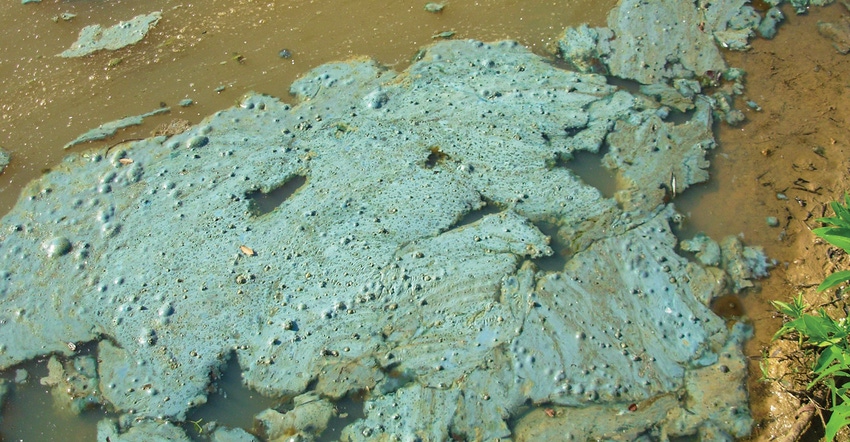August 14, 2020

When seeking relief from the summer heat in ponds and lakes, individuals should be careful not to expose themselves or their pets to harmful algae blooms, Scott Jones, small impoundment Extension specialist for the University of Arkansas at Pine Bluff, said. Toxic algae blooms are most common during the hottest months of summer (July through September) and can pose a health risk.
“Most harmful algae blooms are caused by photosynthetic cyanobacteria commonly known as ‘blue-green algae’ — not ‘true’ algae,” he said. “There are over 2,600 known species of blue-green algae, but only a fraction are known to produce toxins.”
Jones said the toxin-producing species of blue-green algae do not always produce toxins. In fact, the mechanisms driving when they do produce toxins are not well understood.
“This means the presence of a potentially toxic species in your water does not mean that toxins are necessarily present,” he said. “The only way to know for sure if toxins are present is to submit water samples to a capable lab for analysis.”
Blue-green algae can form blooms that discolor the water or produce floating mats or oily surface scums on the water’s surface that have a paint-like appearance. These scums can be blue-green, green, yellow, white, brown, purple, red or grey in color. Other visual signs of blue-green algae include bright green surface streaks and pea-soup green water.
Do-it-yourself test
Jones said there are two do-it-yourself methods individuals can use to test water for blue-green algae.
“Fill half of a pint or quart-sized clear jar with the affected water and leave it in the refrigerator overnight,” he said. “If by morning the green material in the water has settled to the bottom, non-toxic green algae are likely the dominant variety. However, if the green in the water is congregated near the water’s surface, potentially dangerous blue-green algae are likely present.”
Another test can be performed if surface mats are present in the affected water. Dip a long, sturdy stick into the mat and slowly pull it back out. If the stick returns with stringy filaments hanging off, the mat is probably harmless filamentous algae or pondweed. But if the stick appears to have been dipped in green paint, the mat likely consists of potentially dangerous blue-green algae.
If individuals suspect a blue-green algae bloom is under way, they can contact the Arkansas Water Resources Center Water Quality Lab at (479) 502-9843. This lab, as well as other private in-state labs, can identify algae and test for the presence of algal toxins. For a list of labs that perform these tests, contact the Arkansas Department of Environmental Quality at (501) 682-0744. Since an analysis can take several days, individuals should avoid exposure to and keep animals away from the affected water until results are returned.
Prevention strategies
Jones said little can be done when a blue-green algae bloom has been established. Prevention strategies are based on limiting nutrient loads that feed algae blooms in general. These strategies include:
• limiting fertilization of the water and nearby land to what is absolutely necessary.
• only feeding fish amounts of feed they are capable of eating within 10 minutes.
• minimizing unfiltered runoff from agriculture, poultry or livestock production areas directly into surface waters.
• minimizing direct access of livestock to watering sources with fencing and controlled external watering structures.
“While algaecides can kill harmful blue-green algae blooms, extreme caution is advised when using these products,” he said. “Toxin concentrations actually tend to spike after herbicide applications — the algae are stressed and then break apart, potentially increasing the threat of toxicity rather than reducing it.”
When practical, the safest option to get rid of a blue-green algae bloom is to flush the affected water with fresh water to dilute the blue-green algae and the toxins produced. On the other hand, individuals can simply wait until the bloom has dissipated, being vigilant to prevent human and animal exposure to the water in the meantime.
Source: University of Arkansas at Pine Bluff, which is solely responsible for the information provided and is wholly owned by the source. Informa Business Media and all its subsidiaries are not responsible for any of the content contained in this information asset.
About the Author(s)
You May Also Like




